

 |
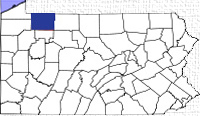 |
 |
||
Part of the PAGenWeb Project |
||||
Cornplanter Cemetery, relocated from its original site, is one of three cemeteries located on a grassy knoll in the extreme northeast corner of the county.
While the Commonwealth of Pennsylvania awarded 600 acres of land in the upper Allegheny valley (just south of the New York state border) to Cornplanter and his heirs “in perpetuity,” in the early 1960s the U.S. Army Corps of Engineers received authorization from Congress to build Kinzua Dam and the Allegheny Reservoir. The dam was completed in 1965 and permanently flooded most of Cornplanter's Grant.
Numerous cemeteries had to be relocated during the construction in the early 1960s by the U.S. Army Corps of Engineers, Pittsburgh District. One of those was the Cornplanter Cemetery (and the Cornplanter Monument) in 1964.
In the same year, Johnny Cash recorded a song about Cornplanter, the broken treaty, and the relocation of his remains: As Long As The Grass Shall Grow.
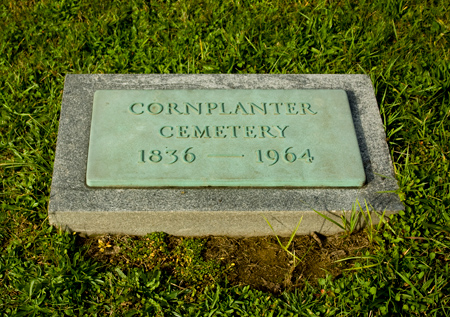 |
The Cornplanter Indian Grant:
Chief Cornplanter
"Pennsylvania's one surviving Indian community lived until 1964 on the Cornplanter Tract in Warren County, northwest Pennsylvania. In that year the newly constructed Kinzua Dam was shut, flooding the Allegheny Reservoir and submerging the community's physical remains.
The Cornplanter Tract was not an Indian reservation, it was a grant of land made in 1791 to Cornplanter, a chief of the Seneca Nation, and to his heirs by the Pennsylvania General Assembly. Through this gift, the government of Pennsylvania expressed its gratitude to Cornplanter for his Indian diplomacy in the early years of American independence.
Cornplanter's people knew him as Kaintwakon, meaning "by what one plants." The white people knew him also as John Abeel (rendered also as Obail) and by other names. He was born to his Seneca Indian mother about 1750 at Ganawagus, near Avon, New York. The Wolf Clan to which she belonged was a ranking Indian family. Among its members were several prominent Indian leaders, Kiasutha, Handsome Lake, Red Jacket, and Governor Blacksnake, all principals in the drama of Indian-white relations which spanned the remainder of the century after 1755. Ultimately, this drama would determine whether this country, especially that part west of the Allegheny Mountains, would be French or English, European or Indian. Chief Cornplanter died in Warren County, Pennsylvania, in 1836. He requested a grave with no marker. A monument has been constructed over his grave."
The monument was erected and dedicated in 1866 by the State of Pennsylvania.
Read more about Chief Cornplanter on Wikipedia and on the Pennsylvania Historical and Museum Commission website.
| Chief Cornplanter's monument sits quite alone on the grassy expanse of the cemetery. |
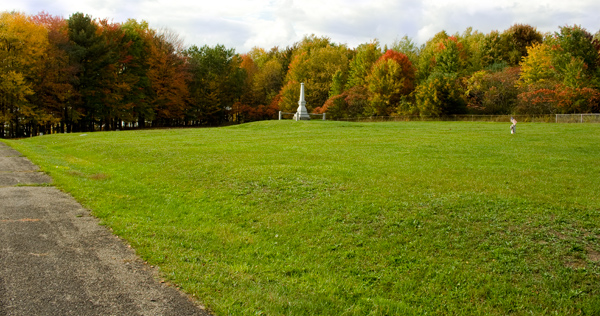 |
| Whether his remains are actually buried there is still subject to speculation. |
| Shown on an undated postcard, the view from the monument looking south. |
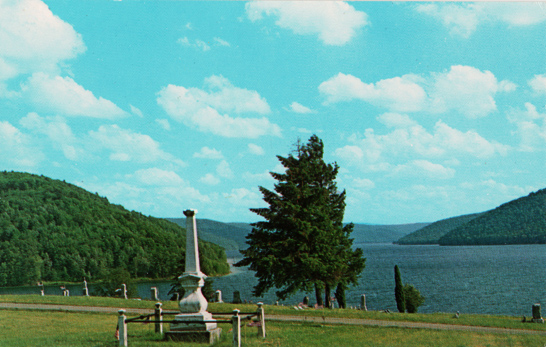 |
| Postcard image courtesy of Warren County Historical Society, Warren, Pa. |
| Portions of the Riverview Cemetery are visible sloping over the hill. |
| In the ensuing years that open view has been lost as the trees and shrubs have grown. |
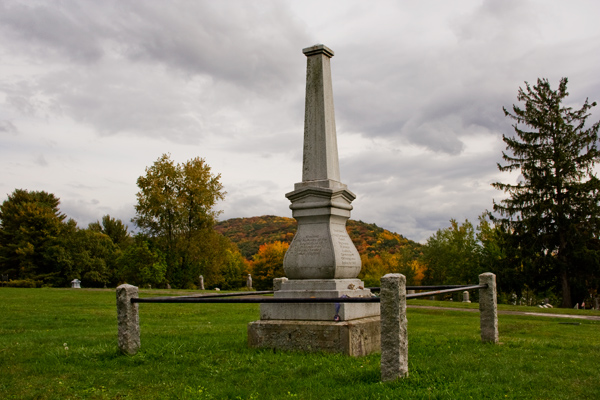 |
| All four sides of his monument bear inscriptions. |
| Also an interesting assortment of pieces of wood, shells, stones and pebbles, feathers, bones, and bits of pottery grace the monument. |
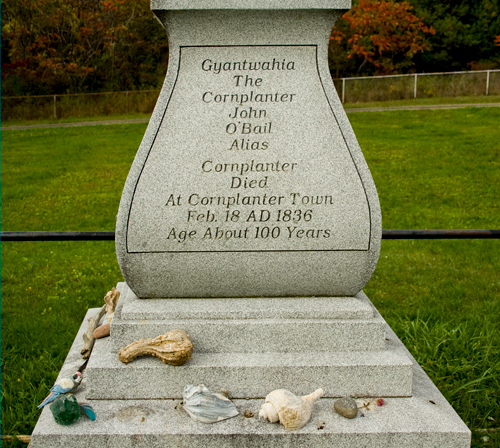 |
| "Gyantwahia The Cornplanter John O'Bail Alias Cornplanter Died At Cornplanter Town Feb. 18 AD 1836 Age About 100 Years" |
| The glimpse of the Allegheny Reservoir is visible through the trees behind the monument. |
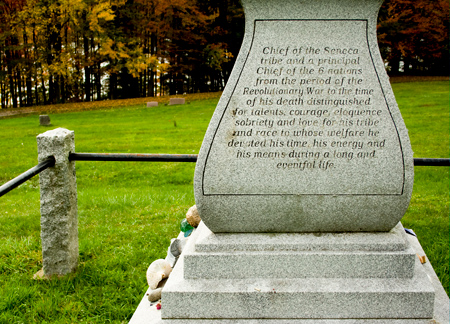 |
| "Chief of the Seneca tribe and a principal Chief of the 6 nations from the period of the Revolutionary War to the time of his death distinguisted for talents, courage, eloquence, sobriety and love for his tribe and race to whose walfare he devoted his time, his energy and his deans during a long a eventful life." |
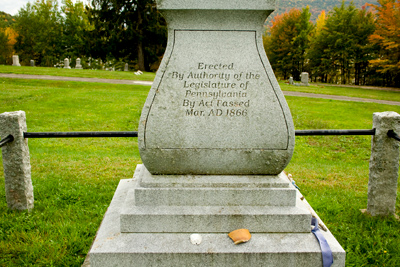 |
| "Erected By Authority of the Legislature of Pennsylvania By Act Passed Mar. AD 1866" |
| This view affords a look east into the Corydon cemetery. |
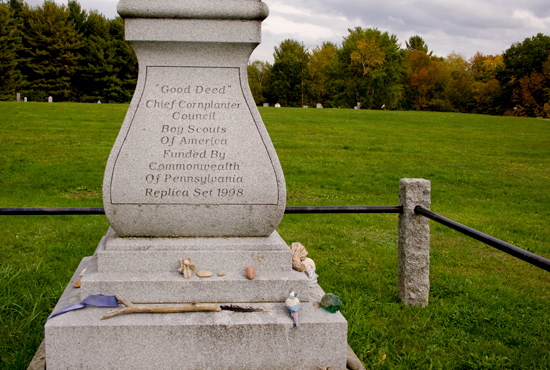 |
| " "Good Deed" Chief Cornplanter Council Boy Scouts of America Funded By Commonwealth Of Pennsylvania Replica Set 1998" |
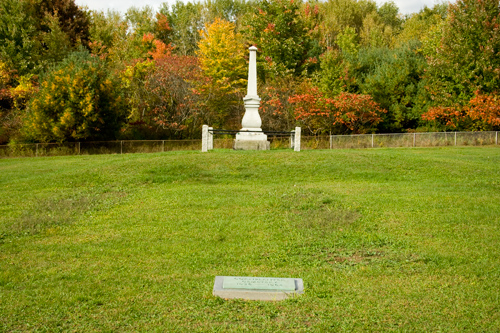 |
| Looking from the paved road, the flat stone bearing the name of the cemetery is set well in front of the monument. |
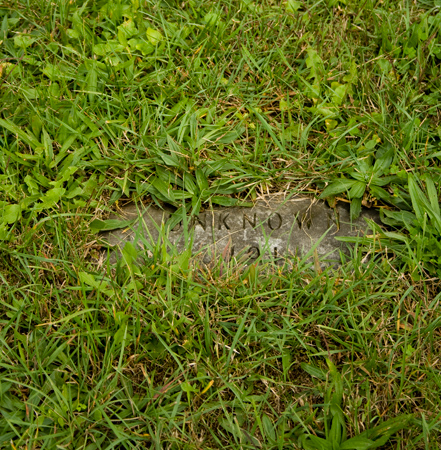 |
| All photographs contributed by Penelope Repko |
| There are, however, numerous flat stones in the cemetery, many bearing the inscription "Unknown." |
Regretably, burials in this cemetery are listed on Find-A-Grave together with the other two cemeteries under the name Riverview Cemetery.
According to Liane Freedman on Norman J. Meinert's webpage, there were 357 graves at Cornplanter Cemetery; of those, 247 were unidentified. Names are listed as obtained from the Corps of Engineers records.
Laura M. Brainard has cataloged and photographed 76 gravestones in the cemetery.
Contributions are always welcome by sending information to the Warren County coordinator.
Return to Elk Township | Warren County Cemetery page | Warren County Genealogy homepage
A proud participant in the USGenWeb and PAGenWeb Projects